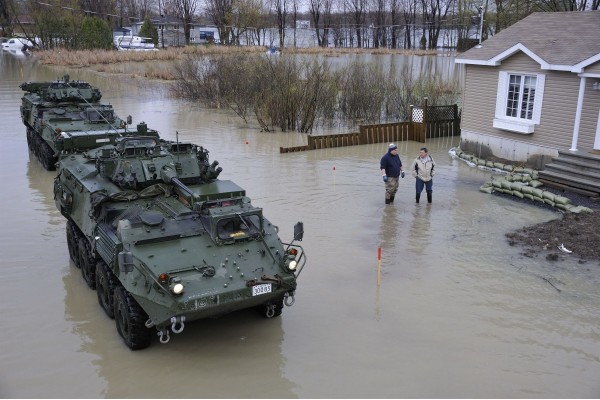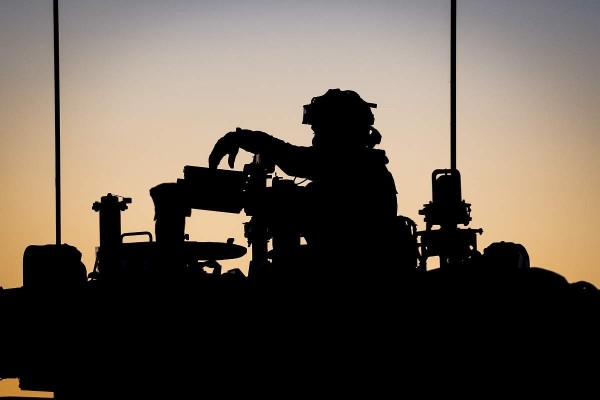Shifting the paradigm on national defence
A changing climate requires rethinking the strategic threats to Canada’s security

Soldiers from the Royal Canadian Regiment support provincial government and municipal authorities in relief efforts during Operation LENTUS, Maugerville, New Brunswick, April 22, 2019. Photo by Sergeant Lance Wade/Flickr.
It is an important point worth reiterating: more Canadians die every year from climate change related disasters and from communicable diseases than from warfare.
The likelihood of a Canadian dying a violent death at the hands of a foreign enemy on Canadian soil is essentially nil, but it is not our military that prevents this from occurring. Canada is geographically isolated, surrounded on three sides by oceans and on the fourth by a friendly nation that considers our national sovereignty to be in their long-term strategic best interest.
Very few nations have the means to project their military forces across oceans (most of them are our allies). Yet, if the geopolitical order disintegrated and Canada’s sovereignty was genuinely threatened, we would have at least enough time to request American assistance in our defence.
In real terms, Canada’s national sovereignty is guaranteed chiefly through convention, diplomacy, a relative degree of inaccessibility, and our proximity to a nuclear-armed superpower that has no quarrel with us.
Not only are we lacking in enemies, our geography alone provides the bulk of our national defence: Canada is simply too remote, too big, and in some respects, too inhospitable, to ever be seriously threatened by a hostile foreign power intent on territorial expansion.
More than any other nation, climate change poses the single greatest security threat, and in several interconnected ways. This reality demands a complete rethinking of how we conceptualize national defence, how we equip our military, and what we train it to do.
To begin with, keeping the Arctic frozen is a strategic necessity: it limits our exposure. It is the reason why Canada has historically been a two ocean navy, and why the bulk of northern defence has been handled by remote radar stations, bush planes, and Inuit patrols armed with First World War era bolt-action rifles (it is strategically preferable that polar bears remain the greatest threat to human life in the Arctic).
An Arctic Ocean open to shipping is not only an environmental concern, but a security threat as well. And while politicians make a big spectacle of new Arctic patrol ships, ‘stealth’ snowmobiles, and new weapons for the Rangers, none of the recent increase in Arctic-related defence spending will ever be sufficient to replace the natural defensive barrier provided by a frozen polar icecap.
Moreover, despite anticipated increases in commercial maritime traffic, a 2014 report indicated that Canada is severely lacking in terms of Arctic oil recovery capabilities.
Our inability to recognize the strategic defensive qualities of a frozen Arctic seems on point for a military still largely designed to fight the Cold War in Europe rather than the climate emergency here at home. This is criminally negligent: as Canadians, there is a far higher likelihood you may perish in a fire, flood, pandemic, or other type of climate change related disaster than in a ground war in central Europe.
Though the spending records of past and present governments leave much to be desired, it is worth noting that the overpriced weapons of war we purchase are themselves adding to the climate crisis. Of all the government ministries and departments, it is the Canadian military that is the single largest carbon emitter, and it is exempt from government carbon reduction targets.
What’s more, Canada’s current big ticket military acquisitions—from the F-35 to the navy’s new surface combatant—have all far exceeded initial budgets, are behind schedule, and promise to complicate our domestic climate goals.
Indeed, the climate crisis is already demonstrating that there is a pressing need for a military we do not seem to have. Thankfully, this problem is currently being discussed by a parliamentary committee.
On October 4, Richard Fadden, a former top-level national security advisor to several previous governments, warned that Canada was becoming overly reliant on its military to provide disaster assistance, which he argued was taking away from its primary role of training for combat missions.
This mentality presumes Canadians are going to be supportive of deploying our military abroad to participate in combat operations. But recent experience suggests that Canadians aren’t particularly enthusiastic about deploying military personnel into foreign war zones. By contrast, the deployment of the military in disaster areas tends to be met with nearly universal support.
The committee was also informed that the need for military-level intervention as a consequence of climate change related disasters is indeed increasing: there were seven requests for military assistance from provincial governments in 2021, and there was an average of four requests per year for the five-year period from 2017 to 2021, up from an average of two requests per year from 2010 to 2017. As reported by the CBC, this increase doesn’t include the 118 requests for assistance the military received during the pandemic.
Recent experience and the testimony of experts continues to point towards Canada’s general unpreparedness to deal with disasters, as well as the fact that, time and again, the military is the only organization with the means, manpower, equipment, and training necessary to help. While there have been proposals in the past to develop a dedicated disaster assistance component within the Canadian military, the strategic implications of climate change suggest instead that the bulk of the military be retooled to focus on disaster and humanitarian assistance as its primary mission.
There are both passive and active aspects of this new defence reality. Whereas in the past Canada built coastal artillery batteries to protect our harbours, today we need army engineers to build dykes, ditches and other defences in flood-prone areas. Whereas in the past we bought interceptors to shoot down enemy bombers, today we need water bombers to intercept forest fires.
Furthermore, this new disaster-focused role need not be confined to Canada: there are (and will be) plenty of disasters the world over where our military’s intervention would be enthusiastically welcomed. This offers the potential of generating incalculable and unprecedented levels of global good will for Canada and its military.
Most importantly, there are considerable strategic advantages in doing so: refocusing they military to address the disasters of the current climate emergency—and developing the means to provide disaster assistance and defence abroad—would give Canada a strategic advantage, potentially allowing us to mitigate the global, ‘trickle-down’ economic and geopolitical consequences of a major disaster.
Consider that the climatological effects of a freak Icelandic volcanic eruption contributed to the underlying causes of the French Revolution.
Whatever stability and security our military affords us, it is nothing compared to what enhancing climate change mitigation measures can provide for ourselves at home, and for nations around the world. The specialized skills that a climate change military would require would further translate into better training for Canadian Forces personnel and a greater likelihood of post-service job placement.
Canadian civil society evidently has a far greater need for trauma nurses, engineers, firefighters, and bush pilots than it does for gunners, paratroopers, or fighter pilots. Best of all, much of the specialized equipment required by a climate change focused military is far less expensive than combat equipment, and can be sourced from domestic suppliers.
Changing times evidently require reconsidering the strategic threats to Canada’s national security, but Canada’s military and political leadership still seem stuck in a decidedly Cold War mentality, letting old ways of thinking, and old priorities, dictate equipment procurement, training, and overall orientation.
In order for Canada’s military to be all it can be—and all the people of Canada need it to be—political leadership needs to reorient military planning to focus on the very real climate change related threats we’re already struggling to adequately deal with, rather than prepare for increasingly suicidal conflicts abroad.
Taylor C. Noakes is an independent journalist and public historian from Montréal. In addition to writing regularly for Canadian Dimension, he contributes to the Toronto Star, Jacobin, Cult MTL, The Maple, DeSmog, and the Montréal Review of Books, among others. He holds an MA in Public History from Duquesne University and has worked on the restoration of playwright August Wilson’s childhood home. He is also a frequent contributor to the Canadian Encyclopedia, and once debated several Canadian prime ministers at once on matters of foreign policy.










